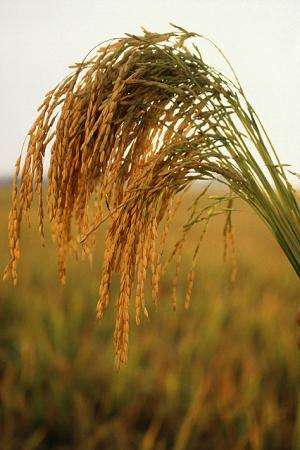Researchers determine beneficial compounds in whole-grain rice varieties

Whole-grain brown rice contains 15 vitamins and minerals, including B vitamins, potassium, magnesium, and iron—all nutrients the body needs to grow and develop normally. In addition to these essential nutrients, there are bioactive phytochemicals in rice, as well as in other whole grains, vegetables, fruits, beans, nuts, and seeds. Although the role of these plant chemicals in terms of human health has not been proven, a body of evidence suggests that some phytochemicals could be nutritionally beneficial.
Now, studies headed by chemist Ming-Hsuan Chen, who is with the Agricultural Research Service's Dale Bumpers National Rice Research Center in Stuttgart, Arkansas, have provided knowledge about the chemical composition and potential bioavailability of compounds in a representative group of rice varieties.
Rice is a cereal grain, along with corn, oats, red and white wheat, and barley. The USDA-ARS National Small Grains Collection (NSGC) in Aberdeen, Idaho, for example, contains more than 18,000 rice samples of various colors, called "accessions," from around the world. These accessions provide a valuable resource to breeders for developing new rice varieties with desirable agronomic and nutritional features.
Rice is categorized into seven color classes based on bran color: white, light brown, speckled brown, brown, red, variable purple, and purple.
Rice bran, an outer layer of whole grain rice, is a rich source of the phytochemical known as "gamma-oryzanol" and of two forms of vitamin E—the tocopherols and the tocotrienols. These nutritional compounds have been linked to preventing oxidative damage in foods and to having a wide spectrum of biological activities.
The team used several assays and analytical methods to determine the profiles of tocopherols, tocotrienols, and gamma-oryzanol in five color classes of bran: white, light brown, brown, red, and purple. They found a wide variation in the concentrations of the two forms of vitamin E and of gamma-oryzanol in the brans of all five color classes studied. "This suggests that breeders can screen the NSGC accessions in all color classes for a high vitamin E and oryzanol content," says Chen.
Studies have shown that pigmented or darker colored cereal grains, such as red and purple, have higher amounts of some phytochemical compounds than nonpigmented varieties. The team also analyzed other phytochemicals—specifically phenolics and flavonoids—in the same five color classes of bran. The researchers wanted to measure the concentrations of both the extractable and the cell-wall bound amounts in the three lighter rice varieties—white, light brown, and brown—and in the two darker rice varieties—red and purple.

Cell-wall bound phenolics and flavonoids in rice grains are of interest because previous studies by other researchers have shown that cell-wall bound phenolic compounds can be broken down by digestive enyzmes and by microflora in the gut. This liberation from the cell wall may mean that these compounds become available for absorption in the body. In addition, the amount of absorbable phytonutrients in rice may be underestimated because typically the cell-wall bound forms have not been measured, says Chen.
To measure phenolic and flavonoid compounds in each rice variety studied, solvents were used to release their extractable amounts, and an alkali solution was used to liberate their cell-wall bound amounts.
The study showed that the red and purple rice brans had higher extracted and cell-wall bound phenolic and flavonoid concentrations than the lighter-colored rice brans measured. Also positive, in the white and light-brown whole-grain rice brans, which are commonly sold in the market, the bound portion of phenolics was found to be about 30 to 50 percent of the total phenolics.
"We found one purple rice bran variety that was both high in phenolic compounds as well as vitamin E and oryzanols" says Chen. Measuring the specific kinds and amounts of phytochemicals in various foods is needed before clinical trials can be conducted to investigate their potential health benefits in humans.
The study findings were published in 2011 in the Journal of Food Science and in 2012 in Food Chemistry.
Consumer reaction is key
Another ARS study has shown flavor differences arising from various colored brans in whole-grain rice. Food technologist Karen Bett-Garber analyzed and characterized rice flavors at the ARS Food Processing and Sensory Quality Research Unit in New Orleans, Louisiana. This sensory research enhances the understanding of the different flavors associated with colored rice brans as perceived by consumers.
"Milled, white rice has been characterized in terms of flavor, but colored whole-grain rice has not," says Bett-Garber. She created a glossary of colored-rice flavors, and flavor differences, of each whole-grain rice type she studied, which will help researchers, breeders, and marketers in describing the flavor of colored whole-grain rice varieties.
The bran layers, along with their unique phytochemical profiles, of all of the rice varieties that Bett-Garber studied were retained (meaning they had not been removed via milling and polishing). For the study, 10 panelists trained in descriptive analysis developed 25 descriptors to define cooked whole-grain rice flavor. They then evaluated the flavor of 22 rice samples with bran that was white, light-brown, dark-brown, red, or purple.
The resulting glossary describes the flavor attributes, as well as other differences, between bran color and types of whole-grain rice. For example, brown rice was described as having more intense grainy-starchy, cooked cereal, and popcorn-buttery flavors. Purple (black) rice was higher in oily, dark-berry, medicinal and smoky-burnt flavors. And red rice had greater intensities for beany, animal-wet dog, and earthy flavors. All in all, the darker rice cultivars tended to have more bitter taste and astringent mouthfeel. The study was published in 2012 in Journal of Sensory Studies.
Challenges for future research and breeding programs include enhancing the nutritional value of rice while preserving and improving its flavor. Together, these studies shed light on the chemical composition and consumer-acceptance potential of colored whole-grain rice varieties.
More information: "Compounds in Whole-Grain Rice Varieties" was published in the April 2013 issue of Agricultural Research magazine. www.ars.usda.gov/is/AR/archive/apr13/
Journal information: Journal of Food Science , Food Chemistry , Agricultural Research
Provided by Agricultural Research Service



















